
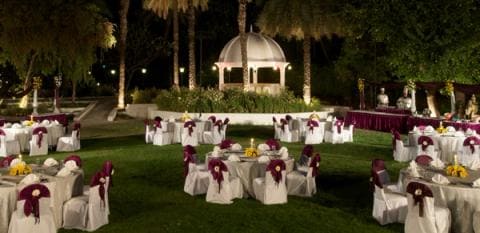
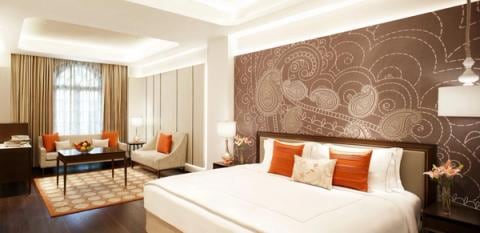
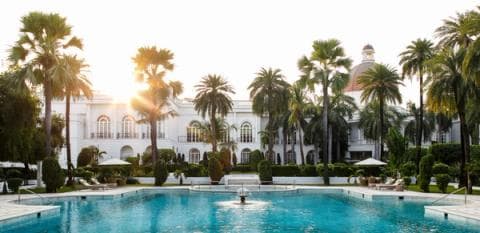
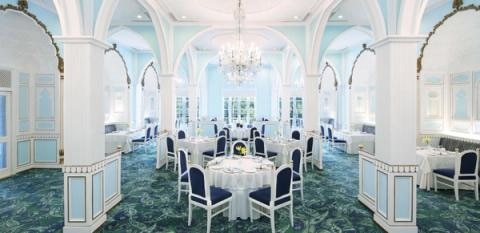
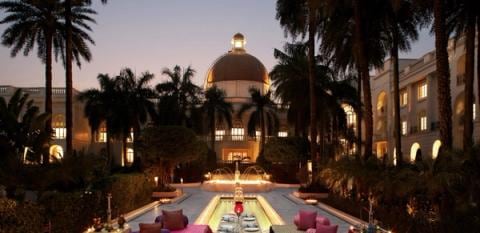
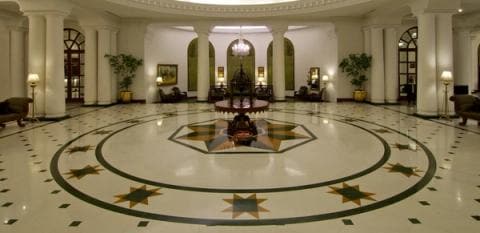







Taj Mahal, Lucknow
Taj Mahal, Lucknow
20 Dec 2025
1 Room
Special Code

Attractions & Places to Visit in Lucknow
Title :
Dilkusha Kothi
Description :
Originally a hunting lodge that later transformed into a summer palace for the nawabs, this Baroque-styled structure stands as a picturesque, off-the-beaten-path ruin today, adorned with a few towers and walls. Come here for a leisurely stroll in the meticulously-maintained garden surrounding the estate.
Dilkusha Kothi
Title :
Bhairavi’s Chikan
Description :
A co-operative that employs and trains over 300 women artisans, as well as (male) weavers, thappakars (block-makers), chhipi (printers) and dhobis (washermen), Bhairavi’s Chikan is dedicated to reviving and preserving the exquisite, delicate art of chikan work (chikankari) which was refined in the eighteenth and nineteenth centuries in Lucknow, under the patronage of the Awadh court. Come here to shop for authentic, hand-embroidered chikankari garments.
Bhairavi’s Chikan
Title :
Chota Imambara
Description :
Housing a mosque, tomb, clock tower, garden and pond, the main attraction of this grand complex is the Imambara itself. The grand hall has the tomb of Muhammad Ali Shah, the third Nawab of Awadh who built his own mausoleum in 1838, as a structure to rival the splendour of the Bara Imambara, which was built by his grandfather. Visit the white marble and limestone monument to marvel at elaborate carvings, paintings and calligraphy. When its chandeliers are illuminated during festivals, the Imambara gloriously lives up to its moniker, ‘Palace of Light’.
Chota Imambara
Title :
Bara Imambara
Description :
Built in 1784 by Nawab Asaf-ud-Daula, the Bara Imambara is an architectural marvel and a testament to Lucknow’s Mughal heritage. Explore the grand central hall - which stands without any supporting beams - and the incredible Bhul Bhulaiya, a puzzling labyrinth of narrow passageways on the upper level that was constructed with 1024 ways to get inside, but only two to come out. The complex also houses the Asfi Mosque and a stepwell (baoli).
Bara Imambara
Title :
Rumi Darwaza
Description :
This iconic 60-feet-tall structure, also known as Turkish Gate, epitomizes Awadhi architecture, while drawing inspiration from Ottoman design. Unlike most gateways built as victory monuments, this architectural gem, built in 1782 by Nawab Asaf-ud-Daula, was born from empathy, a project designed to offer struggling citizens a chance to earn a living with dignity during a harsh famine.
Rumi Darwaza
Title :
The Residency
Description :
Explore the ruins within this British-era complex which played a crucial role during the 1857 uprising for Indian independence. Once a thriving centre across three levels with a billiards room, offices and a library, it now lies in ruins, surrounded by well-maintained gardens. Explore the museum inside that offers a deeper insight into Lucknow’s colonial history, showcasing artifacts and documents from the 1857 uprising, a reminder of the unwavering courage and resilience of the Indian people against British rule.
The Residency
Title :
Chowk Market
Description :
Shop for textiles including Lucknow’s iconic zardozi and chikankari embroidery and taste local delicacies like kulfi and kebabs at this vibrant old city market. It's also famous for its handicrafts. You can shop for ivory items, intricately-carved ivory artefacts, lampshades, knives and toys as well as locally-manufactured ittar (fragrance) made with flowers.
Chowk Market
Title :
Ambedkar Memorial Park
Description :
Spanning 107 acres, this expansive park is a tribute to Indian economist, jurist, social reformer and political leader Dr. Bhimrao Ramji Ambedkar, who chaired the committee that drafted the Constitution of India. Marvel at the grand statues, well-manicured lawns and an imposing stupa-like hemispherical structure as you stroll through the gardens.
Ambedkar Memorial Park
Title :
Nawab Wajid Ali Shah Zoological Garden (Lucknow Zoo)
Description :
Once an 18th century mango orchard known as Banarasi Bagh, Lucknow Zoo was established in 1921 to commemorate the arrival of the Prince of Wales to the city. It’s home to Royal Bengal tigers, white tigers, lions and wolves besides other species. It also features a toy train, a state-of-the-art nocturnal house, a butterfly house, an aquarium and a nature interpretation center.
Nawab Wajid Ali Shah Zoological Garden (Lucknow Zoo)
Title :
Dilkusha Kothi
Description :
Originally a hunting lodge that later transformed into a summer palace for the nawabs, this Baroque-styled structure stands as a picturesque, off-the-beaten-path ruin today, adorned with a few towers and walls. Come here for a leisurely stroll in the meticulously-maintained garden surrounding the estate.
Dilkusha Kothi
Title :
Bhairavi’s Chikan
Description :
A co-operative that employs and trains over 300 women artisans, as well as (male) weavers, thappakars (block-makers), chhipi (printers) and dhobis (washermen), Bhairavi’s Chikan is dedicated to reviving and preserving the exquisite, delicate art of chikan work (chikankari) which was refined in the eighteenth and nineteenth centuries in Lucknow, under the patronage of the Awadh court. Come here to shop for authentic, hand-embroidered chikankari garments.
Bhairavi’s Chikan
Title :
Chota Imambara
Description :
Housing a mosque, tomb, clock tower, garden and pond, the main attraction of this grand complex is the Imambara itself. The grand hall has the tomb of Muhammad Ali Shah, the third Nawab of Awadh who built his own mausoleum in 1838, as a structure to rival the splendour of the Bara Imambara, which was built by his grandfather. Visit the white marble and limestone monument to marvel at elaborate carvings, paintings and calligraphy. When its chandeliers are illuminated during festivals, the Imambara gloriously lives up to its moniker, ‘Palace of Light’.
Chota Imambara
Title :
Bara Imambara
Description :
Built in 1784 by Nawab Asaf-ud-Daula, the Bara Imambara is an architectural marvel and a testament to Lucknow’s Mughal heritage. Explore the grand central hall - which stands without any supporting beams - and the incredible Bhul Bhulaiya, a puzzling labyrinth of narrow passageways on the upper level that was constructed with 1024 ways to get inside, but only two to come out. The complex also houses the Asfi Mosque and a stepwell (baoli).
Bara Imambara
Title :
Rumi Darwaza
Description :
This iconic 60-feet-tall structure, also known as Turkish Gate, epitomizes Awadhi architecture, while drawing inspiration from Ottoman design. Unlike most gateways built as victory monuments, this architectural gem, built in 1782 by Nawab Asaf-ud-Daula, was born from empathy, a project designed to offer struggling citizens a chance to earn a living with dignity during a harsh famine.
Rumi Darwaza
Title :
The Residency
Description :
Explore the ruins within this British-era complex which played a crucial role during the 1857 uprising for Indian independence. Once a thriving centre across three levels with a billiards room, offices and a library, it now lies in ruins, surrounded by well-maintained gardens. Explore the museum inside that offers a deeper insight into Lucknow’s colonial history, showcasing artifacts and documents from the 1857 uprising, a reminder of the unwavering courage and resilience of the Indian people against British rule.
The Residency
Title :
Chowk Market
Description :
Shop for textiles including Lucknow’s iconic zardozi and chikankari embroidery and taste local delicacies like kulfi and kebabs at this vibrant old city market. It's also famous for its handicrafts. You can shop for ivory items, intricately-carved ivory artefacts, lampshades, knives and toys as well as locally-manufactured ittar (fragrance) made with flowers.
Chowk Market
Title :
Ambedkar Memorial Park
Description :
Spanning 107 acres, this expansive park is a tribute to Indian economist, jurist, social reformer and political leader Dr. Bhimrao Ramji Ambedkar, who chaired the committee that drafted the Constitution of India. Marvel at the grand statues, well-manicured lawns and an imposing stupa-like hemispherical structure as you stroll through the gardens.
Ambedkar Memorial Park
Title :
Nawab Wajid Ali Shah Zoological Garden (Lucknow Zoo)
Description :
Once an 18th century mango orchard known as Banarasi Bagh, Lucknow Zoo was established in 1921 to commemorate the arrival of the Prince of Wales to the city. It’s home to Royal Bengal tigers, white tigers, lions and wolves besides other species. It also features a toy train, a state-of-the-art nocturnal house, a butterfly house, an aquarium and a nature interpretation center.
Nawab Wajid Ali Shah Zoological Garden (Lucknow Zoo)
Title :
Dilkusha Kothi
Description :
Originally a hunting lodge that later transformed into a summer palace for the nawabs, this Baroque-styled structure stands as a picturesque, off-the-beaten-path ruin today, adorned with a few towers and walls. Come here for a leisurely stroll in the meticulously-maintained garden surrounding the estate.
Dilkusha Kothi
Title :
Bhairavi’s Chikan
Description :
A co-operative that employs and trains over 300 women artisans, as well as (male) weavers, thappakars (block-makers), chhipi (printers) and dhobis (washermen), Bhairavi’s Chikan is dedicated to reviving and preserving the exquisite, delicate art of chikan work (chikankari) which was refined in the eighteenth and nineteenth centuries in Lucknow, under the patronage of the Awadh court. Come here to shop for authentic, hand-embroidered chikankari garments.
Bhairavi’s Chikan
Title :
Chota Imambara
Description :
Housing a mosque, tomb, clock tower, garden and pond, the main attraction of this grand complex is the Imambara itself. The grand hall has the tomb of Muhammad Ali Shah, the third Nawab of Awadh who built his own mausoleum in 1838, as a structure to rival the splendour of the Bara Imambara, which was built by his grandfather. Visit the white marble and limestone monument to marvel at elaborate carvings, paintings and calligraphy. When its chandeliers are illuminated during festivals, the Imambara gloriously lives up to its moniker, ‘Palace of Light’.
Chota Imambara
Itineraries
Itineraries
TRAVEL STORIES
TRAVEL STORIES
Cultural Sites of Lucknow
GIFT HAMPERS
Taj hampers convey warm sentiments with luxury accessories, culinary treats and artisanal sweets (mithai). Brighten celebrations as you choose from cu...BREAKFAST INCLUSIVE RATE
Wake up to a symphony of flavours with our delectable breakfast spread and enjoy seamless internet connectivity and flexible cancellation for that add...BEST AVAILABLE RATE
Offering an unparalleled blend of plush comfort and elegance, our exclusive room-only rate comes with the added convenience of seamless internet conne...HOTELS IN LUCKNOW
Experience the captivating elegance of Lucknow, a city that combines Mughal and British legacies. Immerse yourself in its rich tehzeeb (culture) and t...NEUPASS
Earn and redeem NeuCoins for exclusive member rates, with your Neupass membership. Indulge in memorable getaways, gourmet delights, spa treatments and...EPICURE
Epicure lifestyle memberships are made for sheer indulgence. Crafted for the creation of special moments, benefits encompass plush rooms & suites, fin...TIMELESS WEDDINGS
Experience the magic of a Taj wedding with our expert planners crafting flawless events, creating timeless memories for generations.J WELLNESS CIRCLE
Embark on a wellness journey infused with ancient Indian healing energies and experiences, revitalizing your mind, body, and spirit.EXCLUSIVE OFFERS
Enjoy exclusive deals on stays, delectable dining experiences, and rejuvenating spa treatments. Elevate your moments with us. Book now to savor unpara...TAJ EXPERIENCE GIFT CARDS
Gift the luxury of a moment that will become a cherished memory. An exclusive experience, carefully selected, crafted and refined by time.GIFT HAMPERS
Taj hampers convey warm sentiments with luxury accessories, culinary treats and artisanal sweets (mithai). Brighten celebrations as you choose from cu...BREAKFAST INCLUSIVE RATE
Wake up to a symphony of flavours with our delectable breakfast spread and enjoy seamless internet connectivity and flexible cancellation for that add...BEST AVAILABLE RATE
Offering an unparalleled blend of plush comfort and elegance, our exclusive room-only rate comes with the added convenience of seamless internet conne...HOTELS IN LUCKNOW
Experience the captivating elegance of Lucknow, a city that combines Mughal and British legacies. Immerse yourself in its rich tehzeeb (culture) and t...NEUPASS
Earn and redeem NeuCoins for exclusive member rates, with your Neupass membership. Indulge in memorable getaways, gourmet delights, spa treatments and...EPICURE
Epicure lifestyle memberships are made for sheer indulgence. Crafted for the creation of special moments, benefits encompass plush rooms & suites, fin...TIMELESS WEDDINGS
Experience the magic of a Taj wedding with our expert planners crafting flawless events, creating timeless memories for generations.J WELLNESS CIRCLE
Embark on a wellness journey infused with ancient Indian healing energies and experiences, revitalizing your mind, body, and spirit.EXCLUSIVE OFFERS
Enjoy exclusive deals on stays, delectable dining experiences, and rejuvenating spa treatments. Elevate your moments with us. Book now to savor unpara...TAJ EXPERIENCE GIFT CARDS
Gift the luxury of a moment that will become a cherished memory. An exclusive experience, carefully selected, crafted and refined by time.GIFT HAMPERS
Taj hampers convey warm sentiments with luxury accessories, culinary treats and artisanal sweets (mithai). Brighten celebrations as you choose from cu...